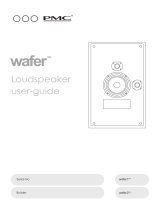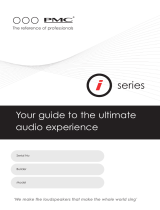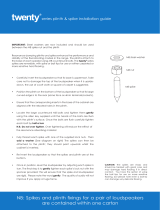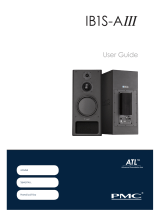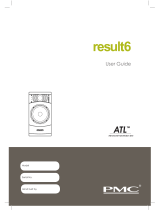Page is loading ...

series user guide
Model
No.
Hand built by


Warranty registration
Please take a few moments to register your new purchase online at
www.pmc-speakers.com (click on ‘Support’ then select ‘Product registration’)
or complete the warranty card at the back of this booklet. This records the
purchase of your loudspeakers and provides you, the customer an opportunity
to make suggestions and provide feedback directly to PMC. To gain your
warranty your product must be registered with us within 10 days of purchase.
Product Support
For product support, accessories or servicing advice, please contact
a PMC authorised dealer – See www.pmc-speakers.com.
IMPORTANT – REGISTER YOUR WARRANTY
THE PROFESSIONAL MONITOR COMPANY LIMITED
HOLME COURT, BIGGLESWADE, SG18 9ST, UK
T +44 (0) 1767 686300
www.pmc-speakers.com
© 2022PMC. All rights reserved.
Ref No: 942 v3 - July 22
PMC Stock Code: 15712



At PMC, we believe that music is what really matters; it’s what moves us
and gives us the passion for what we do.
It’s relatively easy to create loudspeakers that colour or atter music
— but that has never been our way. The quest for sonic neutrality and
transparency has always been PMC’s obsession, using advanced
engineering to reproduce music as vividly and faithfully as possible. Our
designs are involved in every stage of music-making, from the recording
studio to listening at home. From this experience, we know exactly how
to present music as transparently as possible, just as the artist intended.
As we like to say, loudspeakers are where science meets art — we take
care of the science so you can connect with the art.
Peter Thomas, Owner &
Oliver Thomas, Commercial Director
WHAT DRIVES US

CONGRATULATIONS
– YOU HAVE JOINED THE ELITE
UNIVERSAL MUSIC GROUP
Thomas Newman
Royal College of Music
Afrojack
Warner Music
Kraftwerk
Pinewood Studios
Capit Studios
EMI
Stevie Wonder
BBC
Tony Bennett
Coldplay
elbow
ESPN
SONY
Apple
You have joined the elite. You’re a
PMC user.
Our loudspeakers can be found in all
the world’s best listening environments,
from audiophile living rooms to
internationally renowned recording,
mastering, broadcast and post-
production studios. Our Emmy-award-
winning systems are used to create
everything from smash Hollywood
soundtracks to hit albums by artists
including Coldplay, Kraftwerk, Elton
John and Adele, as well as audiophile
jazz and classical recordings on
Deutsche Grammophon, Decca,
Philips and Harmonia Mundi.
Whether you listen to our speakers in
world-class studios in LA, London, Berlin
or Tokyo, or in your favourite listening
room at home, you will hear the music
exactly as the artist intended it.

General usage guidelines
PMC’s ATLTM
(Advanced Transmission Line)
Our meticulous attention to detail
Unpacking
Resonance-absorbing stand installation guide
Connections - plugging them in
Running in or breaking in
Positioning
Fine tuning for perfect bass
Stereo set up
Surround sound specic set up
Ideal 5.1 surround sound set up
Ideal 7.1 surround sound set up
Service
Specications
Inspection certicate
Warranty online
Conditions of warranty
Warranty certicate
Help us improve – Your comments
Tip
Tip
Tip
Tip
Tip
Tip
Tip
Tip
Tip
Tip
Tip
Tip
Tip
Tip
Tip
Tip
Tip
Tip
Tip
Tip
Tip
Tip
Tip
Tip
Tip
Tip
Tip
Tip
Tip
Tip
Tip
Tip
Tip
Tip
Tip
Tip
Tip
Tip
Tip
Tip
CONTENTS

Tip
Tip
Read these instructions and keep them in a safe place for future reference.
Tip
Tip
Heed all electrical safety warnings, including any on the loudspeakers themselves.
Tip
Tip
Do not use the loudspeakers near water.
Tip
Tip
The cabinet should only be cleaned with a dry, lint-free, cloth. Do not use solvents,
abrasives, waxes or liquids as they may be detrimental to the nish.
Tip
Tip
Four soft, cork rubber disks are included with the all “XBD” systems these
can be attached to the base of the unit to provide vibration-free operation.
Floor spikes are sharp; treat with great care during installation and use.
Tip
Tip
Do not install near any heat sources such as radiators, ovens or other equipment
that produce excessive heat.
Tip
Tip
Unplug this product from both source and power during electrical storms, or when
unused for extended periods of time.
Tip
Tip
Packing material can pose danger to the young and vulnerable. Ensure these
items are kept or disposed of safely.
Tip
Tip
High volume audio signals, however short their duration, have the potential to
cause hearing damage. Use care when setting the system volume level to ensure
playback sound pressure levels remain within safe comfortable limits.
Tip
Tip
Do not attempt to service the equipment. There are no user serviceable parts
inside. Please refer all servicing to PMC authorised personnel.
Tip
Tip
Servicing is required when the apparatus is damaged, exposed to moisture,
or exhibits a distinct or sudden change of operation or audio performance.
Tip
Tip
PMC has made efforts to provide accurate installation information and good
quality xings. PMC will not be held responsible or liable for injuries or property
damage – direct, indirect or consequential – arising out of use or inability to use
this product safely and properly.
Tip
Tip
Series loudspeakers contain very powerful magnets and therefore may have
a detrimental effect if left in close proximity to magnetically sensitive items.
Do not use the vent as a grip to lift the loudspeaker as this may result in
damage.
GENERAL USAGE GUIDELINES
Tip
Tip
Tip
Tip
Tip
Tip

TM
Advanced Transmission Line
The source of PMC’s legendary natural and wholly realistic sound is the Advanced Transmission
Line (ATLTM) bass-loading technology.
ATLTM is an ingenious design which uses energy generated by the bass unit in a much more
intelligent and efcient way than speaker designs based on ported or sealed boxes.
In ATLTM loudspeakers, the highly braced cabinet is lined with a multitude of custom-designed
acoustic materials that absorb all but the very lowest frequencies. These are guided to exit from
a vent on the front-panel, extending the low-frequency response and creating the impression
of a far larger speaker with an extra, ultra-high quality bass unit.
ATLTM improves more than just the bass response: because the low end is clean and clear it
doesn’t mask the rest of the music. Vocals in particular, are beautifully projected and ultra-
vivid.
ATLTM loudspeakers offer another benet. The ATLTM bass extension does not change with volume
level – so even when listening quietly the bass sounds balanced and well dened.
This cross-sectional view of the BB5
loudspeaker shows the ATLTM
cabinet
Tip
Tip

Tip
Tip
OUR METICULOUS ATTENTION TO DETAIL
All PMC loudspeakers are designed and hand-built in the U.K. using individual
components that are matched to our reference model; this includes the structural
integrity of every cabinet and the testing and recording of each component.
This guarantees it will be within our strict tolerances and ensures your purchase
sounds identical to the original design. Each completed loudspeaker then
undergoes a set of objective and subjective measurements - frequency response
sweeps ensure that the design meets our exacting performance criteria, and
then listening tests are conducted against the reference model using a wide
variety of material, from a benchmark BBC speech test to classical music,
pop and rock.
OUR METICULOUS ATTENTION TO DETAIL
Computers don’t tell the full story. As well as a
full frequency analysis, we listen to each speaker
we make and run a benchmark BBC speech and
music test on every single one.



Tip
Tip
UNPACKING
Please retain your packaging for future use as all PMC
cartons are durable, reusable and can be employed
to safely transport your loudspeakers should they be
relocated or returned for servicing.
Much of the packing is constructed from recyclable
materials, so if you are to dispose of it please do so in an
environmentally friendly manner.
Packing materials can pose danger to animals, the
young and vulnerable. Ensure these items are kept or
disposed of safely.
!

RESONANCE-ABSORBING STAND
INSTALLATION
Tip
Tip
Resonance damping stands are provided with spikes to enhance the performance
and stability of these models in the series range.
Tip
Tip
Tip
Tip
Carefully invert the loudspeakers stand so that its base is uppermost. Take care
not to damage the top of the stand when it is upside-down; the use of a soft
cloth or square of carpet is suggested.
Screw the proprietary stand spikes into the M8 threaded inserts in the base of
the stand.
Rotate the stand so that spikes are on the oor,you are now ready to place
your stands in situe and nish the installation of your loudspeakers.
N.B. Do not over-tighten. Over-tightening the spikes, over tigthening of the
spikes will result in failure of the mounting inserts.
Caution: The spikes are sharp and should be treated with great care; they may
damage hard ooring if in direct contact.
Tip
Tip
!
!

CONNECTIONS
Tip
Tip
Caution
To avoid potential damage, please ensure that your power amplier(s) or
receiver is turned off before connecting or disconnecting your loudspeakers.
Cable & connectors
When selecting cables for use with your series loudspeakers, ensure that
their construction is of a high enough standard to withstand the rigors of
everyday use and that they are suitably terminated. While bare wire can be
accommodated by the series binding posts, we recommend the use of
either spade lugs or 4mm ‘banana’ plugs in order to maintain an electrical
connection of the highest integrity and avoid the possibility of short circuits.
Please consult your dealer for more information regarding cable lengths and
termination options.
Do not use tools to tighten the binding posts
Polarity + & –
It is of vital importance to observe the polarity markings and maintain
positive-to-positive and negative-to-negative connections from amplier
or receiver to the loudspeaker. The series terminals are colour-coded to aid
in their identication: positive terminals are red, negative terminals are black.
!
!
Plugging them in

When loudspeakers are new they will take time to reach their full potential.
It is often debated whether any solid-state equipment, such as CD players
or transistor-based power ampliers change with use, but the characteristics
of mechanical devices such as loudspeakers do alter and improve their
performance signicantly after a short ‘running in’ period.
The science is simple; as the soft material surrounding the dome or woofer
cone is exed it will eventually reach a point where it has optimum compliancy
allowing the drive unit to move more freely. This translates to greater accuracy
and speed of attack in the bass region and the mid and high frequency
produces a far more vivid audio picture. This short ‘running in’ period takes
approximately 50 hours of normal use.
50+ hours to run-in
Tip
Tip
RUNNING IN OR BREAKING IN
12
11
10
9
8
765
4
3
2
1
50
HOURS

With their unique ATLTM Advanced Transmission Line design, wide dispersion, ultra
low distortion and smooth bass roll-off, PMC loudspeakers are more forgiving of
difcult room conditions and placement constraints than conventional designs
so you will be able to achieve a superb sound throughout the room with little
effort. We do encourage you to spend some time experimenting in your own
room in order to achieve the very best results. Remembering that small changes
in location can often inuence system performance.
Room shape, size, construction and interior decoration vary immensely and
therefore inuence sound in different ways. The following guidelines are
suggestions for the starting point to locate your new speakers. Fine-tuning of their
positioning can start from here.
Tip
Tip
Positioning
POSITIONING

Tip
Tip
Tip
Tip
Tip
Tip
Tip
Tip
• Place the speaker so the front face is slightly forward of any large object that
protrudes into the room – eg. a replace, bookcase or television.
See stereo set up diagram
• Ensure that stereo pairs of loudspeakers are equidistant from the listening position.
• It is best to position the front left/right pair (and centre channel loudspeaker if you
have a surround system) at the same height, usually at ear-level when seated at
the listening position.
If any of the speakers are mounted above or below ear level, then angle the
speaker towards the listening position.
• The distance between your left/right speakers and the listening position should
ideally be equal. As a general rule, the width of the audio picture will be narrow
if the speakers are too close together. If they are too far apart the picture will be
wide but there will be less central denition.
Use a well recorded vocal track to judge the ideal spot.
• To enhance the audio picture/soundstage and sound balance, the speakers can
be angled/toed-in. With the speakers facing straight ahead play a well recorded
vocal track. Gradually toe-in both speakers by small increments (max 5° at a time)
(see stereo set-up diagram) until the voice is vivid and centrally placed. You can
ensure this is best position by going ‘one step too far’ then returning. Then, use
a track with extended high frequencies such as cymbals, check that they sound
clear but not overpowering. If they sound too loud or harsh subtly toe the speakers
out by very small increments until you achieve the ideal balance; then repeat
both listening tests to conrm.
A simple, well-recorded band with vivid vocals will help to nd the best position.
POSITIONING
Tip
Tip

Bass / LF (Low Frequency adjustment)
Solid boundaries (i.e. walls, ceilings and oors) reect sound and help to contain
it within a room. They make a speaker sound louder the closer they are to them,
especially in the low frequency (bass) region.
This diagram shows the areas, that if a speaker is positioned, will either increase
or decrease bass – The darker the shading the more bass will be heard.
Placing the speakers in the corners will generate the most bass, and in the centre
of the room, the least bass.
FINE TUNING FOR PERFECT BASS
Tip
Tip
/


